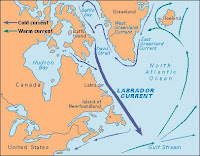The Gulf of St. Lawrence in eastern Canada is rapidly losing oxygen, declining by as much as 55 percent in some spots since the 1930s — compared to a 2 percent drop globally. Now, new research has found that the region’s dramatic oxygen decline is due largely to climate change and shifts in the major ocean currents that feed the gulf.
The study, published this month in the journal Nature Climate Change, found that the Labrador Current, which carries water from the Arctic south along the North American East Coast, has weakened in recent decades. Meanwhile, the Gulf Stream has shifted northward, transporting more warm, salty, and oxygen-poor water from the Caribbean into the Gulf of St. Lawrence.
While water in the Labrador Current is typically well-churned by storms in the Labrador Sea, which pushes oxygen to lower ocean depths, the Gulf Stream is more stratified, with its deeper layers very oxygen-deprived.
“Observations in the very inner Gulf of St. Lawrence show a dramatic oxygen decline,” Mariona Claret, an ocean modeler at the University of Washington and lead author of the new study, said in a statement. The area is “reaching hypoxic conditions, meaning it can’t fully support marine life.”
The near-hypoxic conditions in the gulf — a major fishing and tourism hub — have already caused Atlantic wolffish populations to decline and are threatening cod, snow crabs, and halibut.
Read more at The Gulf of St. Lawrence is Losing Oxygen Faster than Almost Any Other Marine Environment

No comments:
Post a Comment